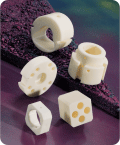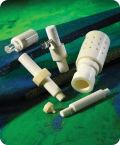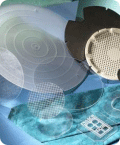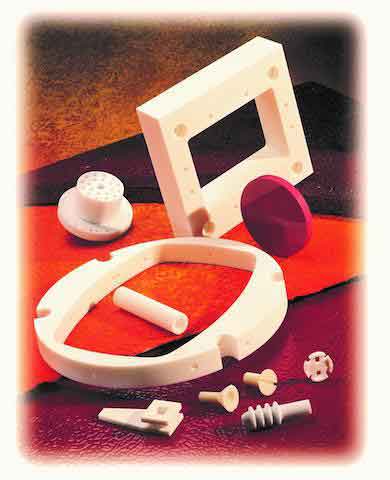When you need to solve an especially complex design challenge, look to ceramics.
Modern technical ceramics offer amazing material properties and features when compared to conventional steels, plastics, or other non-ferrous materials. Ceramics typically offer very high hardness, wear resistance, compression strength, and electrical resistance – as well as minimal susceptibility to acids or caustics.
Some ceramics, such as a CVD-produced silicon carbide, offer additional advantages by allowing fairly high thermal conductivity, along with some electrical conductivity. By contrast, aluminum nitride allows fairly high thermal conductivity along with very low electrical conductivity.
When developing a new application for ceramics, check with material experts early in the design process to understand which properties can be easily obtained, and which might be limiting. Our Designer’s Guide is a resource for your designers to explore the properties of common ceramics:
Challenges of Technical Ceramics
Technical ceramics present a host of challenges. Many, like alumina or zirconia, are produced by pressing powders or pastes into rough shapes before firing at low temperature, creating a fragile “green” ceramic. It is possible to machine a green ceramic to add holes or flats or other features before the final high-temperature firing that results in the solid product.
High-temperature firing, however, causes significant shrinkage that, despite careful algorithms, can’t guarantee tolerances better than a couple percent of the desired dimension. If you need precision features such as holes or perpendicularities, or dimensions of +/-.001”, you can achieve it only after firing, which adds considerable cost. However, you can save dramatically if you don’t need such tight tolerances.
Diamond Grinding
Most metals are machined by single-point cutting. However, this technology does not work on fired ceramics, because they are generally harder than the cutter. Of course, there are always exceptions, and in this case single-point cutting can be done with a diamond chip, but this is only useful for very specialized situations.
As a rule, fired technical ceramics are “machined” by grinding, and most such grinding involves diamond grinding wheels. These wheels are made with diamond grit embedded in metals or composites that remove the material by impact.
Grinding is a tedious process that requires intense cooling of the impact/cutting zone due to high applied pressure, and to protect the diamond grits from heat fracture. “Tedious” and “diamond” imply higher costs, but due to material stability, it is possible to achieve remarkably tight tolerances and fine features that will remain stable far longer than other material choices.
On a microscopic scale, the impact of diamond grit on alumina – or its single-crystal version sapphire – is quite violent. Because its properties are similar to alumina, sapphire is specified for window or lens applications where glass is insufficient – such as high pressure, excessive wear, or chemicals. But polishing sapphire requires eliminating, or minimizing on a microscopic scale, any subsurface damage. So after diamond grinding to achieve form, the piece will be polished using diamond slurries with ever-finer grits. As with all diamond-on-ceramic processes, removing heat from the operation is critical to avoid piece damage and to keep the diamond edges sharp.
Aerospace, Semiconductors, and Other Applications
Technical ceramics – especially sapphire – can improve the performance of components subjected to extreme conditions. This can be especially valuable when steel or glass parts are subject to frequent and unpredictable failure that causes machine stoppage.
In a process flow, sudden stoppages will create very large downtime costs, which can justify the use of a higher-cost ceramic component. Ceramic parts can also be specified for severe applications like high-temperature environments, or where conventional materials just won’t work. Applications include aerospace, semiconductor, oil field, and medical areas.
With over 70 years of experience, China Hard Materials Parts is recognized as an industry expert for machining super-hard materials, including ceramics, sapphire, and quartz. We recommend that a designer always try conventional materials like steel or aluminum or glass first, as these materials are readily available and easily machined or formed cost-effectively.
But a designer should always keep technical ceramics in mind. Their properties can lead to major process improvements – or even breakthroughs – that can easily justify higher fabrication costs.
About China Hard Materials Parts
China Hard Materials Parts has been fabricating precision parts from all technical ceramics since 1947. Approximately a third of our machining involves sapphire, but our capabilities go way beyond that. China Hard Materials Parts engineers welcome inquiries from designers contemplating specifying technical ceramics for their applications, whether prototype or full production. We only ship parts that meet agreed-to requirements, but are often able to respond to challenges and achieve results others cannot.




